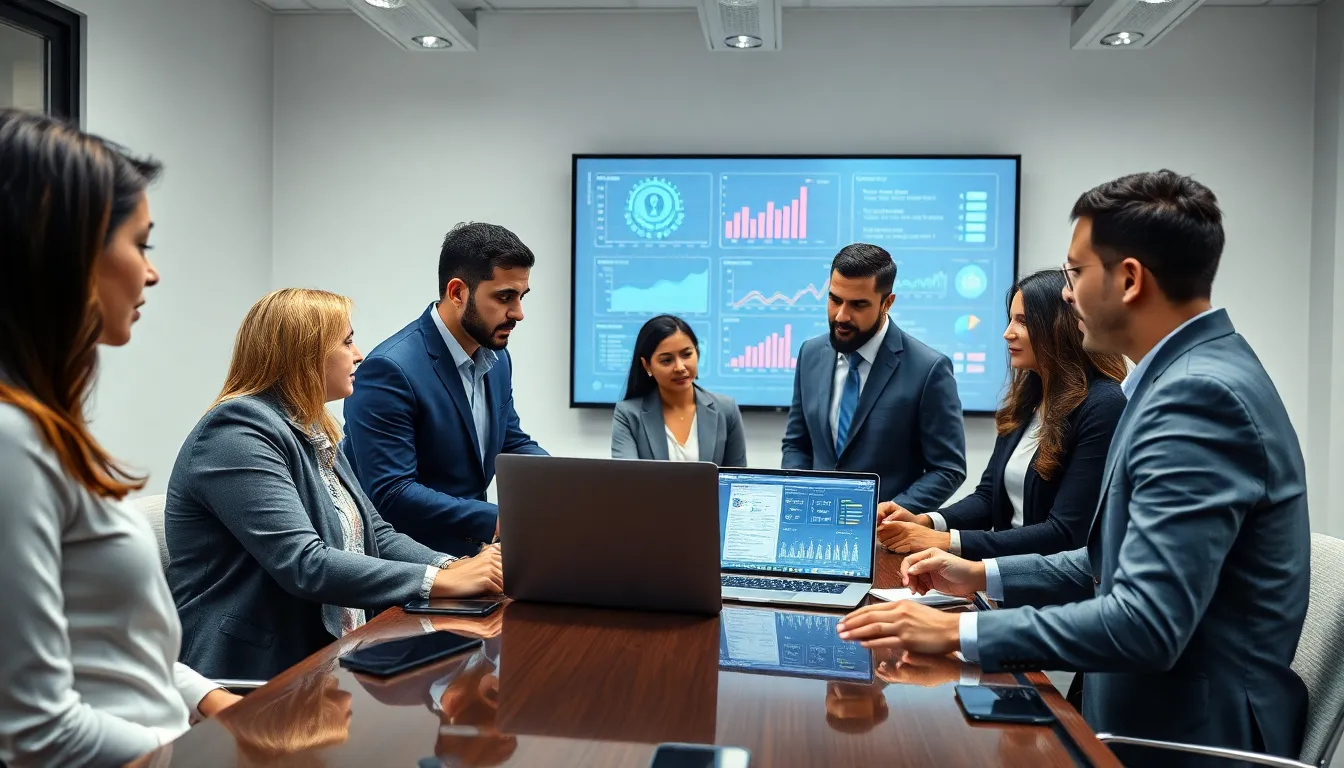In a world where smartphones have become extensions of ourselves, mobile security management isn’t just a buzzword—it’s a necessity. Picture this: your phone holds everything from embarrassing selfies to sensitive bank info. Now imagine losing it or worse, having it hacked. Yikes, right?
Table of Contents
ToggleOverview Of Mobile Security Management
Mobile security management refers to the strategies and technologies focused on protecting handheld devices and their data. Organizations prioritize mobile security to protect sensitive information from unauthorized access. Remote work trends amplify these security challenges, as employees frequently use personal devices for work tasks.
Mobile device management (MDM) serves as a critical component. MDM solutions provide tools for securing, monitoring, and managing mobile devices within a corporate environment. Implementations often include device lock, remote wipe, and encryption features.
Threats to mobile security typically include malware, phishing, and data leakage. Phishing attacks deceive users into revealing personal information, such as passwords or credit card details. Malware infiltrates devices, often disguised as legitimate applications.
Policies governing mobile security should focus on user training and device compliance. Employees must understand the risks and follow protocols for securing devices. Regular audits assess compliance with security policies.
Data protection techniques contribute to a robust mobile security posture. Encryption ensures that data remains unreadable to unauthorized users. Regular software updates patch vulnerabilities, reducing the risk of exploitation.
Investing in mobile security management significantly mitigates risks associated with mobile device use. It empowers organizations to maintain control over their sensitive data, supporting a secure and productive environment. Organizations must view mobile security as an ongoing priority due to the ever-evolving threat landscape.
Key Components Of Mobile Security

Mobile security management involves several critical components to safeguard devices and data effectively.
Device Management
Device management plays a crucial role in securing mobile endpoints. Organizations implement Mobile Device Management (MDM) solutions to enforce security policies. These tools provide capabilities for remote wipe, device encryption, and application control. They also support monitoring compliance with organizational policies and configurations. Additionally, businesses can track device usage and access history for audit purposes. In cases of lost or stolen devices, MDM helps prevent unauthorized access to sensitive information. Prioritizing device management helps reduce vulnerabilities associated with mobile usage.
Data Protection
Data protection strategies are vital for defending sensitive information stored on mobile devices. Encryption serves as a key technique, rendering data unreadable without the correct decryption key. Regular backup of data ensures recovery in the event of a malware attack or accidental deletion. Organizations also focus on secure data transmission methods, such as VPNs, which encrypt data while in transit. Further, adhering to compliance regulations like GDPR enhances data protection measures. Implementing these strategies effectively mitigates risks associated with data leaks and breaches.
Application Security
Application security is essential in preventing unauthorized access to mobile applications. Businesses evaluate app permissions to limit access to unnecessary data and functionalities. Conducting regular assessments of both in-house and third-party applications helps identify vulnerabilities. App hardening techniques, including code obfuscation and runtime security checks, enhance overall security posture. Furthermore, organizations educate users on recognizing malicious apps and phishing attempts. By prioritizing application security, companies safeguard sensitive data against potential threats targeting mobile applications.
Best Practices For Mobile Security Management
Implementing best practices for mobile security management ensures organizations protect sensitive data effectively. Prioritizing employee training, regular updates, and consistent risk assessments enhances overall security.
Employee Training
Employee training represents a vital aspect of mobile security management. Organizations should educate employees on identifying phishing attacks and understanding malware risks. Engaging training sessions can raise awareness about security policies and best practices. Providing resources like handbooks or online courses enables staff to reinforce their knowledge. Regularly scheduled refreshers keep security practices top of mind and adapt to emerging threats.
Regular Updates
Regular updates play a crucial role in maintaining mobile security. Outdated software often contains vulnerabilities that cybercriminals exploit. Organizations must enforce policies requiring timely updates for operating systems and applications. Automating software updates simplifies the process and ensures devices run the latest security patches. Monitoring devices for compliance helps verify that all updates are applied effectively.
Risk Assessment
Conducting regular risk assessments is essential for identifying potential vulnerabilities. Evaluating mobile devices and applications allows organizations to recognize areas requiring improvement. Frequency of assessments should align with changes in technology and threat landscape. Involving cross-functional teams during assessments encourages a holistic view of security risks. Actionable insights gained from assessments enable organizations to prioritize security measures effectively.
Challenges In Mobile Security Management
Mobile security management faces numerous challenges that can jeopardize sensitive data. Organizations must address these evolving threats proactively.
Malware Threats
Malware poses significant risks to mobile devices. Often disguised as legitimate applications, it can infiltrate systems and compromise data. Cybercriminals frequently use malware to steal personal information or conduct unauthorized financial transactions. Protection against such threats involves employing advanced antivirus software and ensuring regular updates to address vulnerabilities. Users also benefit from being cautious about downloading unfamiliar applications to minimize exposure. The expansion of malware targeting mobile platforms makes diligent monitoring and defense essential for organizations committed to data security.
Insider Threats
Insider threats represent another critical challenge in mobile security management. These threats can arise from employees accidentally or intentionally misusing their access to sensitive data. Employees may share passwords or fail to follow security protocols, leading to potential breaches. Regular training significantly reduces the likelihood of insider threats by educating staff on best practices and promoting awareness of security risks. Monitoring user behavior and implementing strict access controls enhance the overall security framework for organizations. Addressing insider threats requires a balanced approach that combines proactive measures and a culture of responsibility among employees.
Future Trends In Mobile Security Management
Emerging technologies reshape mobile security management. Artificial intelligence plays a pivotal role in threat detection, analyzing patterns to identify anomalies in real time. Machine learning algorithms improve response times, addressing potential risks before they escalate.
Increased adoption of zero trust architecture reinforces security protocols. Trust no user or device by default enhances overall protection, particularly in remote work environments. Organizations implement strong identity verification methods, ensuring only authorized access to sensitive data.
The rise of 5G technology influences mobile security management significantly. With increased connectivity comes heightened risk, necessitating advanced security measures. Improved bandwidth also allows for better encryption techniques that safeguard data transmission.
Integration of secure access service edge (SASE) becomes critical. SASE unifies networking and security services, delivering secure authentication and data protection within a single framework. This converged approach simplifies management while bolstering security.
Focus on mobile threat defense (MTD) solutions expands. MTD tools specifically target mobile devices, protecting against malware and phishing attacks effectively. Organizations increasingly rely on these solutions to monitor device behavior and flag suspicious activities.
User awareness remains a top priority. Regular training sessions emphasize cybersecurity best practices, addressing the importance of recognizing social engineering tactics. Informing employees about current threats helps create a security-conscious organizational culture.
Deployment of robust data loss prevention (DLP) strategies also gains traction. DLP tools monitor and manage data flows, preventing unauthorized transfers outside the organization. This proactive measure protects critical information effectively.
Investments in mobile security management are essential as the threat landscape evolves. Organizations must continuously adapt to new risks, ensuring their defenses remain resilient against sophisticated attacks. Prioritizing state-of-the-art technologies and practices fosters a secure mobile environment.
Mobile security management is no longer optional; it’s essential for safeguarding sensitive data in a rapidly evolving digital landscape. Organizations must prioritize comprehensive strategies that encompass device management, data protection, and application security to mitigate the risks posed by various threats.
Investing in employee training and maintaining up-to-date software are critical steps in building a robust defense against cyber threats. As technology advances, staying ahead of emerging risks will require a proactive approach and the integration of innovative solutions.
By embracing these practices, businesses can create a secure environment that not only protects their assets but also fosters trust among employees and customers alike.









